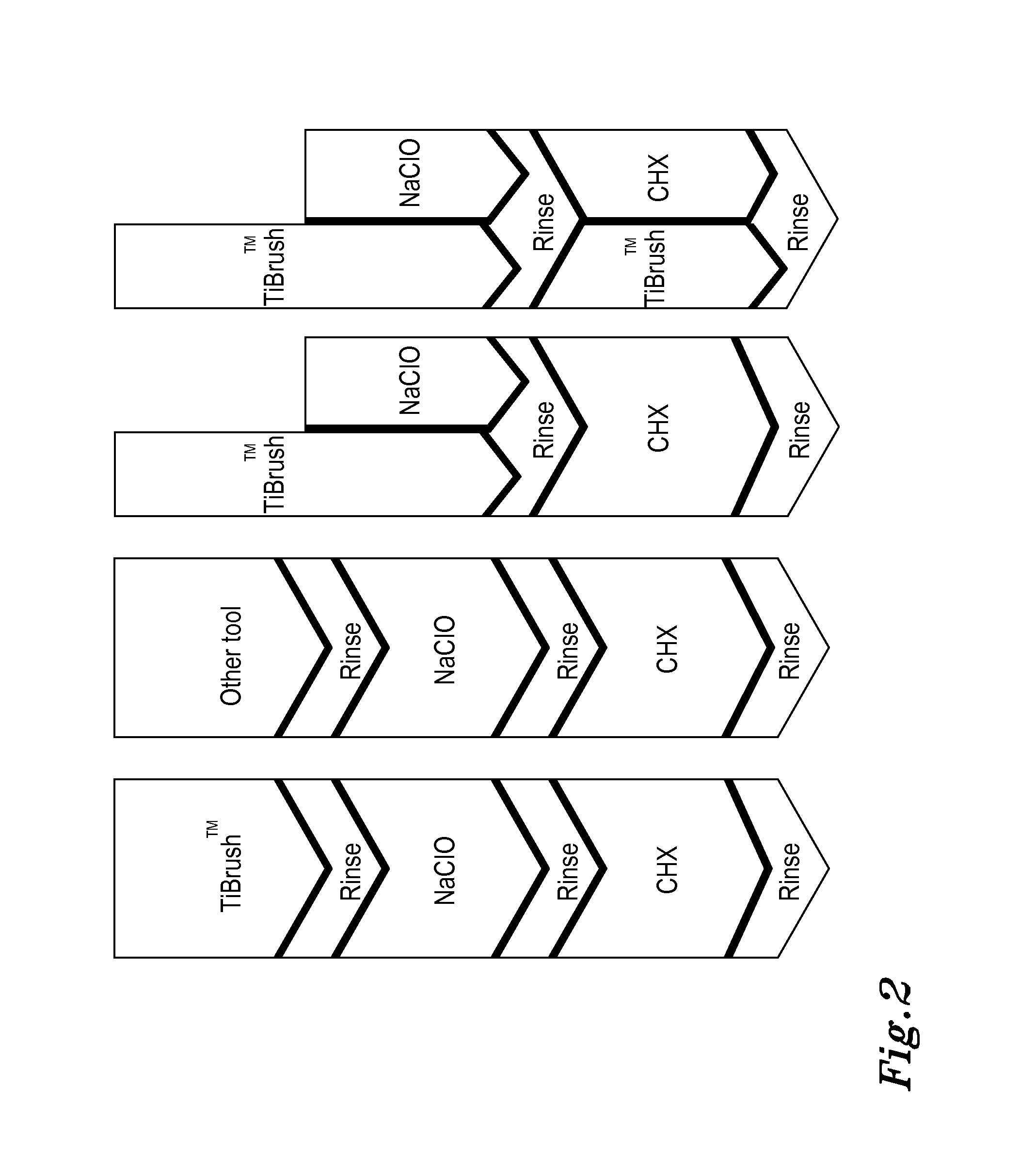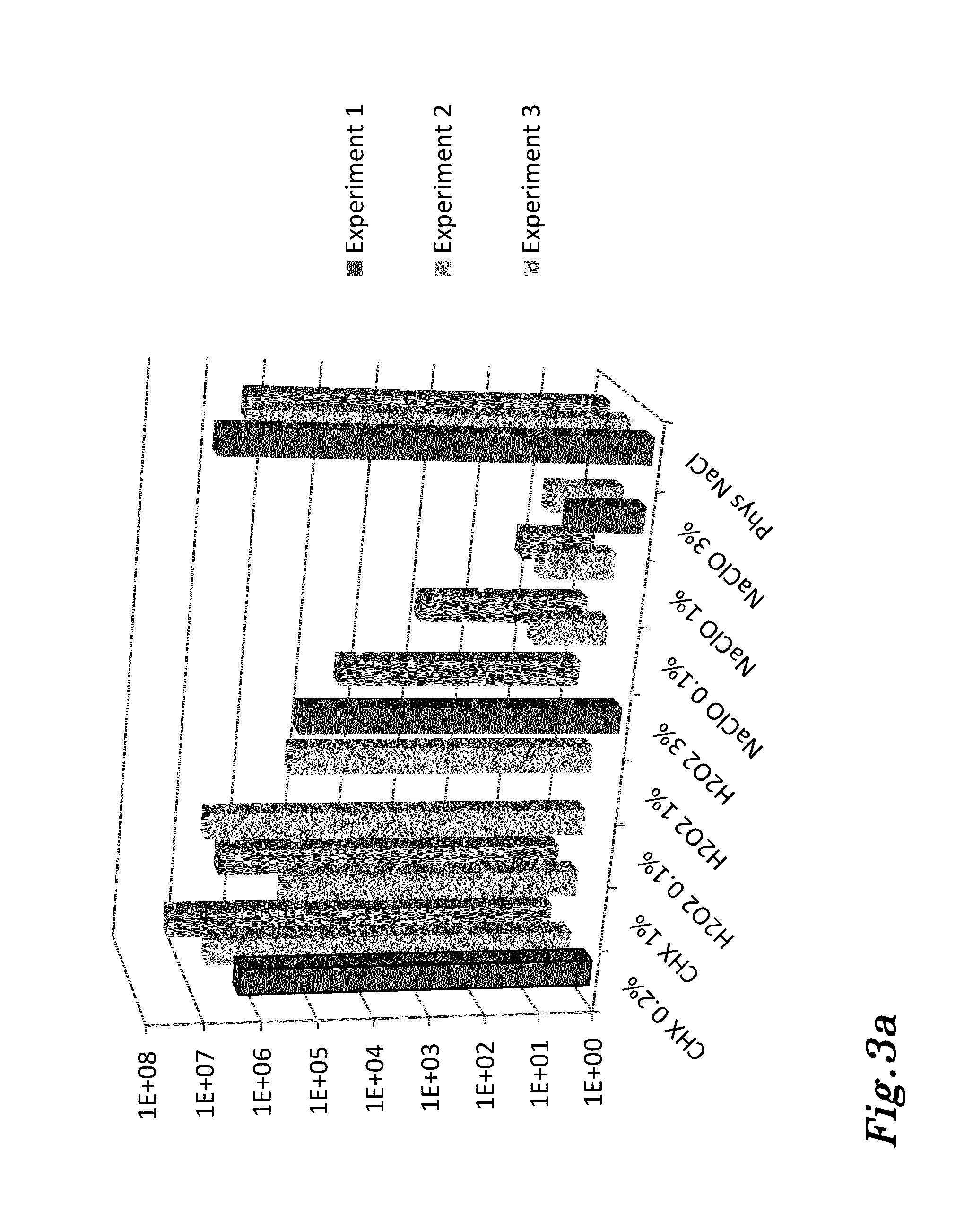Periodontal disease treatment
a periodontal disease and treatment technology, applied in dental tools, tooth pluggers/hammers, dental tools, etc., can solve the problems of tooth-supporting tissues being destroyed, oral biofilms becoming more complex, and complex treatmen
- Summary
- Abstract
- Description
- Claims
- Application Information
AI Technical Summary
Benefits of technology
Problems solved by technology
Method used
Image
Examples
experiment 1
[0214
[0215]Evaluation of Biofilm Decontamination with Various Antimicrobial Solutions Tested in a 70 / 30 Supragingival Biofilm Model
[0216]For a detailed description of the biofilm model used in this experiment, see e.g. Guggenheim et al., 2004, 2001a; and Shapiro et al., 2002 and Guggenheim et al., 2009.
[0217]Strains:
[0218]OMZ 918, Streptococcus mutans
[0219]OMZ 493, Veilonella dispar
[0220]OMZ 598, Fusobacterium nucleatum
[0221]OMZ 607, Streptococcus oralis
[0222]OMZ 745, Actinomyces oris
[0223]OMZ 110, Candida albicans
[0224]Test Solutions:
Test solutions:After dip:24 h after dip:Chlorhexidine, 0.2%n = 3n = 3Hydrogen peroxide, 3%n = 3n = 3Sodium hypochlorite, 3%n = 3n = 3Phys. NaCln = 3n = 3Chlorhexidine, 0.2%n = 3n = 3
[0225]Results:
[0226]As can be seen in FIG. 7, compared to the saline control, chlorhexidine (CHX), and hydrogen peroxide (H2O2), had very modest immediate decontaminating effect. In contrast, the effect immediately after exposing the biofilms to sodium hypochlorite wa...
experiment 2
[0229
[0230]Evaluation of Biofilm Decontamination with Various Antimicrobial Solutions Tested in a 70 / 30 Supragingival Biofilm Model
[0231]For a detailed description of the biofilm model used in this experiment, see e.g. Guggenheim et al., 2004, 2001a; and Shapiro et al., 2002 and Guggenheim et al., 2009.
[0232]Strains:
[0233]OMZ 918, Streptococcus mutans
[0234]OMZ 493, Veilonella dispar
[0235]OMZ 598, Fusobacterium nucleatum
[0236]OMZ 607, Streptococcus oralis
[0237]OMZ 745, Actinomyces oris
[0238]OMZ 110, Candida albicans
[0239]Test Solutions:
Test solutions:After dip:24 h after dip:Chlorhexidine, 0.2%n = 3n = 3Chlorhexidine, 1%n = 3n = 3Hydrogen peroxide, 0.1%n = 3n = 3Hydrogen peroxide, 1%n = 3n = 3Sodium hypochlorite, 0.1%n = 3n = 3Sodium hypochlorite, 1%n = 3n = 3Sodium hypochlorite, 3%n = 3n = 3Phys. NaCln = 3n = 3
[0240]Results:
[0241]As can be seen in FIG. 8, the results of this experiment show the good reproducibility of the biofilm test. With regard to test solutions already app...
experiment 3
[0246
[0247]Evaluation of Subgingival Biofilm Decontamination with Various Antimicrobial Solutions Tested in a Subgingival Biofilm Model
[0248]For a detailed description of the biofilm model used in this experiment, see e.g. Guggenheim et al., 2004, 2001a; and Shapiro et al., 2002 and Guggenheim et al., 2009.
[0249]Strains:
[0250]OMZ 278, Prevotella intermedia
[0251]OMZ 493, Veilonella dispar
[0252]OMZ 598, Fusobacterium nucleatum
[0253]OMZ 607, Streptococcus oralis
[0254]OMZ 661, Treponema denticola
[0255]OMZ 698, Campylobacter rectus
[0256]OMZ 745, Actinomyces oris
[0257]OMZ 871, Streptococcus anginosus
[0258]OMZ 925, Porphyromonas gingivalis
[0259]OMZ 1047, Tannerella forsythia
[0260]Test Solutions:
Test solutions:After dip:24 h after dip:Chlorhexidine, 0.2%n = 3n = 3Chlorhexidine, 1%n = 3n = 3Hydrogen peroxide, 3%n = 3n = 3Sodium hypochloride, 0.1%n = 3n = 3Sodium hypochloride, 1%n = 3n = 3Phys. NaCl, Controln = 3n = 3
[0261]Results:
[0262]The purpose of the present biofilm experiment ...
PUM
| Property | Measurement | Unit |
|---|---|---|
| time | aaaaa | aaaaa |
| thick | aaaaa | aaaaa |
| thick | aaaaa | aaaaa |
Abstract
Description
Claims
Application Information
 Login to View More
Login to View More - R&D
- Intellectual Property
- Life Sciences
- Materials
- Tech Scout
- Unparalleled Data Quality
- Higher Quality Content
- 60% Fewer Hallucinations
Browse by: Latest US Patents, China's latest patents, Technical Efficacy Thesaurus, Application Domain, Technology Topic, Popular Technical Reports.
© 2025 PatSnap. All rights reserved.Legal|Privacy policy|Modern Slavery Act Transparency Statement|Sitemap|About US| Contact US: help@patsnap.com



